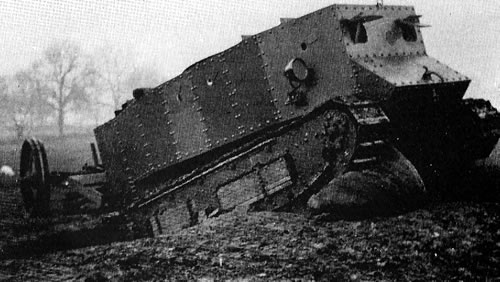After the successful trials of the Killen-Strait the committee decided to test two more American tractors, namely the Bullock ‘Creeping Grip’ machines. First they tried coupling two machines together with an articulated platform, but this proved extremely difficult to maneuver and the coupling often snapped off. After this a bizarre attempt at adding six wooden legs to a Bullock tractor was undertaken, with the feet designed to walk alongside the machine and lift it out of sticky mud and hollows. Not surprisingly, the ‘Elephants Feet’ idea was dropped, along with many other trial and error experiments that led us up to the invention of the tank.
Still, despite many failures during trials, it was very clear that tracks were the right tool for the job, so the tracks from the Bullock were copied onto a more suitable vehicle built by Fosters. William Tritton, who’d previously failed with his attempts to make his Trench Crosser successful, teamed up with Walter Wilson on August 11 1915 to design a new vehicle running on specially lengthened Bullock tracks – the ‘Number One Lincoln Machine’. The machine had a box-like body, made from steam engine boiler plating, and was already built and running in trials by September 14th 1915, only a month after initial designs were undertaken. The powerhouse was a 105 horsepower Daimler gasoline engine, previously used in Foster tractors. It had a two-speed gearbox and worm reduction gear to the rear sprockets that drove the tracks. Tails wheels, a little like canon wheels, trailed behind as an aid to steering and cross-country handling. The Number One Lincoln Machine didn’t have any weapons, however a false turret was fitted to simulate the weight distribution of a two-pounder gun.
The idea of this machine was sound, but the adapted American tracks caused a lot of problems, often coming off their rollers due to the strains of performing outside their intended use. Also the machine itself could not cross the full specified width of a First World War trench, i.e. 5 feet (1.5m) , so it was tantamount to useless as a weapon on the battlefield. However, the machine was outstanding as a prototype and led the way forward towards a functional war machine.
 Wilson and Tritton soon realized that they’d have to design and make their own tracks, specifically for their machine, if they were going to get it to work properly. After a lot of experiments and failed attempts, they eventually came up with a cast-steel track plate that was riveted to hinged links with guides to engage rails on the track frames to stop the whole ensemble working loose. The original machine was rebuilt to accommodate these new tracks, with lengthened frames, so it was able to cross the War Office’s specified 5 foot gap.
Wilson and Tritton soon realized that they’d have to design and make their own tracks, specifically for their machine, if they were going to get it to work properly. After a lot of experiments and failed attempts, they eventually came up with a cast-steel track plate that was riveted to hinged links with guides to engage rails on the track frames to stop the whole ensemble working loose. The original machine was rebuilt to accommodate these new tracks, with lengthened frames, so it was able to cross the War Office’s specified 5 foot gap.
Wilson and Tritton named their new machine ‘Little Willie’. She was the first ever purpose built, from the ground up, armored fighting vehicle with tracks – almost the first ‘tank’.
Some argue, however, that though ‘Little Willie’ can be thought of as the first tank, or at least the first armed, armored vehicle with tracks, it is its successor, Big Willie or ‘Mother’ Tank, that first saw active service in battle and, therefore, it could be said that the ‘Mother’ tanks were indeed the first actual battle tanks. Still, Little Willie led the way and it was her track system that was used on all British tanks built during the First World War.